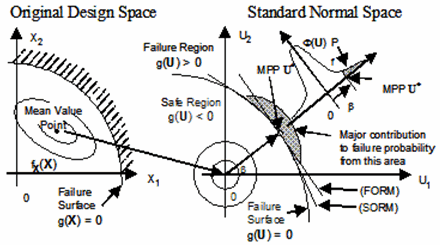First Order Reliability Method (FORM) | ||||
|
| |||
The figure below presents a graphical representation of First Order Reliability Method (FORM ) and the Second Order Reliability Method (SORM) concepts.

FORM takes advantage of the desirable properties of the standard normal probability distribution. Hasofer and Lind (1974) defined the reliability index as the shortest distance from the origin of the standard normal space (U-space) to a point on the failure surface. Mathematically, determining the reliability index is a minimization problem with one equality constraint:
In this equation a transformation is introduced to map the original random vector (in X-space) to the standard, uncorrelated normal vector using ). The solution of the minimization problem in U-space, , is called the Most Probable Point (MPP).
If the failure function is linear in terms of the normally distributed random variables , the failure probability is calculated as
In this equation is the standard normal distribution function. If the failure function is nonlinear or the random variables are not normally distributed, a good approximation can still be obtained using the equation above, provided that the curvature of the failure surface at the MPP is not too large in magnitude.
The algorithm used to solve for the MPP in the FORM method is the traditional Hasofer-Lind-Rackwitz-Fiessler (HL-RF) method, a special scheme that does not require line search during optimization. The HL-RF method was originally derived from the Kuhn-Tucker necessary condition by Hasofer and Lind (1974). Rackwitz and Fiessler (1978) suggested that non-normally distributed random variables can be transformed to equivalent normal variables for use in the Hasofer-Lind reliability analysis.